9 Different types of Metal Casting Process Advantages and Disadvantages
1-3 types of Metal Casting Process Please click:
Pros and Cons for Sand Casting, Investment Casting,and Die Casting
4. Low pressure casting
Low pressure casting: refers to the method of making liquid metal fill the mold under low pressure (0.02~0.06MPa) and crystallize under pressure to form castings.
(1) Process flow: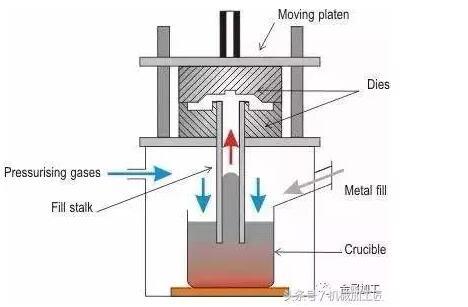
(2) Technical features:
① The pressure and speed during pouring can be adjusted, so it can be used for casting various kinds of castings (such as metal mold, sand mold, etc.), various alloys and castings of various sizes;
② The bottom injection mold filling is adopted, which makes the liquid metal mold filling stable and free of splash, avoiding the entrapment of gas and the scouring of mold wall and core, and improving the qualification rate of castings;
③ The casting crystallizes under pressure, with dense structure, clear contour, smooth surface and high mechanical properties, which is particularly beneficial to the casting of large and thin wall parts;
④ The feeding riser is omitted, and the metal utilization rate is increased to 90~98%;
⑤ Low labor intensity, good working conditions, simple equipment, easy to realize mechanization and automation.
(3) Application: Mainly traditional products (cylinder head, wheel hub, cylinder frame, etc.).
5. Centrifugal casting
Centrifugal casting: It is a casting method in which molten metal is poured into a rotating mold, and the mold is filled and solidified under the action of centrifugal force.
(1) Process flow: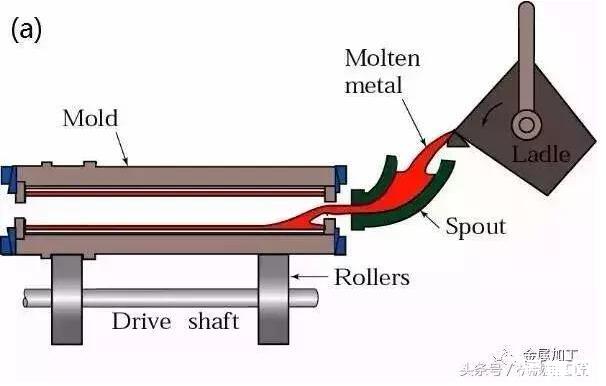
(2) Advantages:
① There is almost no metal consumption in the gating system and riser system, which improves the process yield;
② The core can not be used in the production of hollow castings, so the metal filling capacity can be greatly improved in the production of long tubular castings;
③ The casting has high density, less porosity, slag inclusion and other defects, and high mechanical properties;
④ It is convenient for manufacturing barrel and sleeve composite metal castings.
(3) Disadvantages:
① There are some limitations when it is used to produce special-shaped castings;
② The inner hole diameter of the casting is inaccurate, the inner hole surface is relatively rough, the quality is poor, and the machining allowance is large;
③ Castings are prone to specific gravity segregation.
(4) Application:
Centrifugal casting was first used to produce cast pipes. Centrifugal casting process was adopted in metallurgy, mining, transportation, irrigation and drainage machinery, aviation, national defense, automobile and other industries at home and abroad to produce steel, iron and non-ferrous carbon alloy castings. Among them, the production of centrifugal cast iron pipe, cylinder liner and shaft sleeve of internal combustion engine is the most common.
6. Gravity die casting
Metal mold casting: refers to a molding method in which liquid metal is filled with metal mold under the action of gravity and cooled and solidified in the mold to obtain castings.
(1) Advantages:
① The thermal conductivity and heat capacity of the metal mold are large, the cooling rate is fast, the structure of the casting is dense, and the mechanical properties are about 15% higher than those of the sand mold casting;
② The castings with higher dimensional accuracy and lower surface roughness value can be obtained, and the quality stability is good;
③ Because sand cores are not used or rarely used, the environment is improved, dust and harmful gases are reduced, and labor intensity is reduced.
(2) Disadvantages:
① Since the metal mold itself has no permeability, certain measures must be taken to derive the air in the mold cavity and the gas generated by the sand core;
② The metal mold is non yielding, and the casting is easy to crack during solidification;
③ The manufacturing cycle of metal mold is long and the cost is high. Therefore, only in mass production can good economic results be achieved.
(3) Application:
Metal mold casting is not only suitable for mass production of nonferrous alloy castings such as aluminum alloy and magnesium alloy with complex shape, but also suitable for production of iron and steel castings, ingots, etc.
7. Vacuum die casting
Vacuum casting: It is an advanced die casting process that eliminates or significantly reduces the porosity and dissolved gas in the die casting by removing the gas in the die casting mold cavity during the die casting process, thereby improving the mechanical properties and surface quality of the die casting.
(1) Process flow: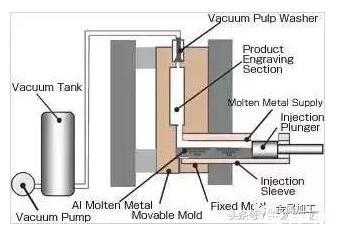
(2) Advantages:
① Eliminate or reduce the air hole inside the die casting, improve the mechanical properties and surface quality of the die casting, and improve the plating performance;
② Reduce the back pressure of the mold cavity, use the alloy with low specific pressure and poor casting performance, and it is possible to use small machines to cast larger castings;
③ The filling condition is improved, and thinner castings can be diecasted.
(3) Disadvantages:
① The die sealing structure is complex, and the manufacturing and installation are difficult, so the cost is high;
② If the vacuum die casting method is not properly controlled, the effect is not very significant.
8. Squeezing die casting
Squeeze casting: It is a method to make liquid or semi-solid metal solidify under high pressure, flow to form, and directly obtain parts or blanks. It has the advantages of high utilization rate of liquid metal, simplified process and stable quality. It is an energy-saving metal forming technology with potential application prospects.
(1) Process flow: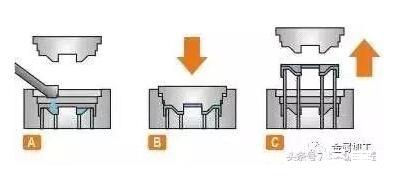
① Direct squeeze casting: coating spraying, alloy casting, mold closing, pressurization, pressure maintaining, pressure relief, mold parting, blank demoulding and resetting;
② Indirect squeeze casting: coating spraying, mold closing, feeding, mold filling, pressurizing, pressure maintaining, pressure relieving, mold parting, blank demoulding, and resetting.
(2) Technical features:
② Low surface roughness and high dimensional accuracy;
③ It can prevent casting cracks;
④ It is easy to realize mechanization and automation.
(3) Application: It can be used to produce various types of alloys, such as aluminum alloy, zinc alloy, copper alloy, ductile iron, etc
9. Lost wax casting
Lost Wax Casting (also known as full mold casting): it is a new casting method that combines paraffin wax or foam models similar to the size and shape of castings into model clusters, brushes fire-resistant coatings and dries them, buries them in dry quartz sand for vibration molding, pours them under negative pressure, vaporizes the models, liquid metal occupies the mold position, and solidifies and cools them to form castings.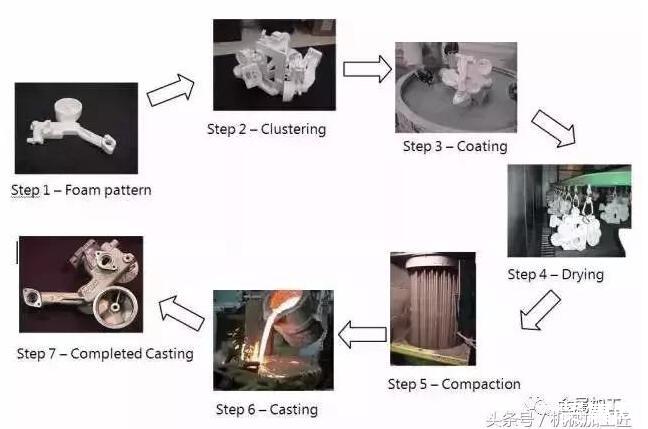
(1) Process flow: pre foaming → foaming molding → coating dipping → drying → molding → pouring → sand falling → cleaning
The classification, advantages and disadvantages of common casting processes are introduced in detail!
(2) Technical features:
① High casting precision, no sand core, reduced processing time;
② No parting surface, flexible design, high degree of freedom;
③ Clean production, no pollution;
④ Reduce investment and production costs.
(3) Application:
It is suitable for the production of precision castings of various sizes with complex structures, with unlimited alloy types and production batches. Such as gray cast iron engine box, high manganese steel elbow, etc.
Choosing the right casting method depends on factors such as the desired production volume, part complexity, material requirements, and budget considerations. Each method has its own niche applications and is well-suited to specific manufacturing needs.
Dongrun Casting have 20000 square meters facility houses and 200 production & test equipment, From quotation and tooling design to casting and finished machining, we can work with you at every stage. We serves wide range of industries-from Fortune 500 corporations to small and midsize OEMs. Our products includes: Automotive&Trucking, Electric Utility & Communications, Metering System, Hydraulic Industry, Medical Devices, Lighting, Fuel and Gas Pressure, Furniture parts.
More Details : www.dongruncasting.com
